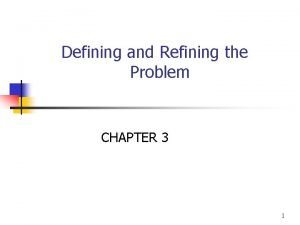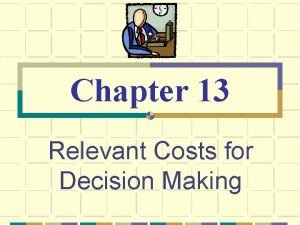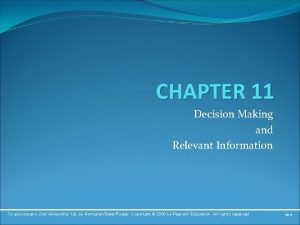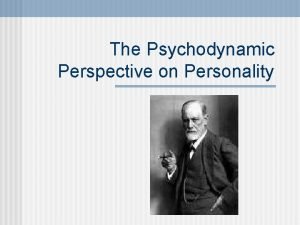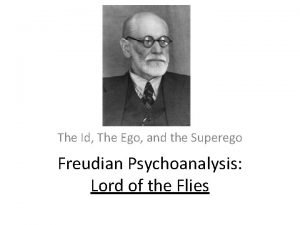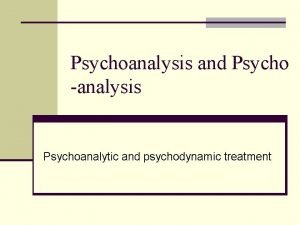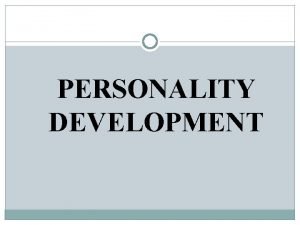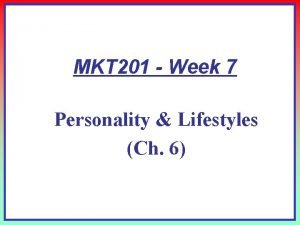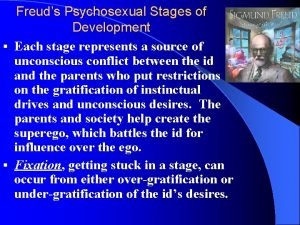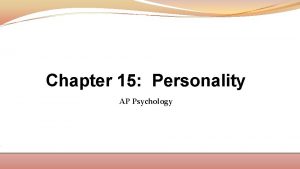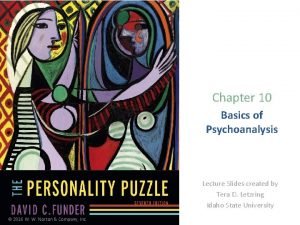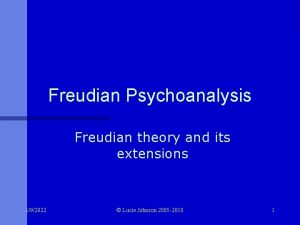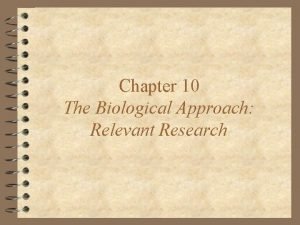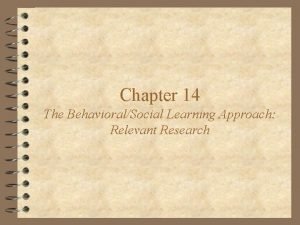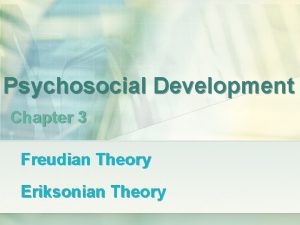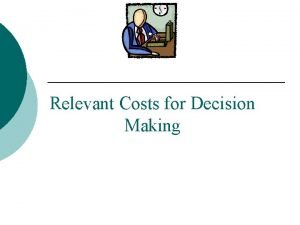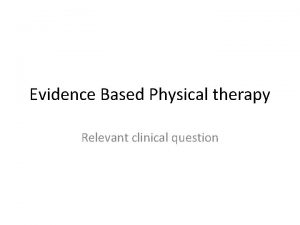Chapter 4 The Freudian Approach Relevant Research Dream



























- Slides: 27

Chapter 4 The Freudian Approach: Relevant Research

Dream interpretation 4 Manifest content versus latent content 4 Symbols representing unconscious thoughts, feelings, and desires – – Penis: tower, fountain, pencil, snake Vagina: cave, box, pouch, doorway Sexual intercourse: dancing, riding, climbing Male erection: flying, sailing a kite

Percentage of male dream characters for men and women (Hall, 1984) 4 Data collected across many different cultures around the world reveal that males make up about 50% of the characters in women’s dreams, but about 65% of the characters in men’s dreams. 4 Why? How can we account for this striking difference? 4 Freud’s explanation: unresolved feelings of conflict with the father deriving from the Oedipus complex. 4 Alternative explanations?

Anxiety and recurrent dreams 4 Researchers find that most recurrent dreams include threatening images, usually in the context of situations in which the dreamer is in danger (Zadra, Desjardins, & Marcotte, 2006). 4 People who report recurrent dreams also report a higher level of anxiety in waking life (Brown & Donderi, 1986; Zadra, O’Brien, & Donderi, 1998). How would the psychoanalytic approach account for this finding? 4 College students who have recurrent dreams report more of them during exam weeks than in weeks without exams. 4 People with higher levels of anxiety also report more classic sexual symbols in their dream content (pencils, boxes, flying, etc. ) than people with lower levels of anxiety do (Robbins, Tanck, & Houshi, 1985).

Common beliefs about dreaming: True or false? 4 4 Dreams last only a few minutes. Dreams occur only before waking. Many people dream rarely or not at all. Dreams can’t hurt you. Research findings indicate that all of these beliefs are false.

Sleep labs

Common beliefs about dreaming: True or false? 4 4 Dreams last only a minute or two. Dreams occur only before waking. Many people dream rarely or not at all. Dreams can’t hurt you. Research findings indicate that all of these beliefs are false.

Cycles of sleep stages

Common beliefs about dreaming: True or false? 4 4 Dreams last only a minute or two. Dreams occur only before waking. Many people dream rarely or not at all. Dreams can’t hurt you. Research findings indicate that all of these beliefs are false.

Percentages of total sleep time spent in REM sleep Species % sleep time in REM Birds 1% Sheep 20% Humans 25% Cats 60%

Percentages of total sleep time in REM sleep for humans at different ages Age group % sleep time in REM Premature infant 80% (estimated) Full-term infant 50% 5 -week-old infant 40% 3 -year-old child 30% Typical adult 25% Elderly person 15%

Evidence for the value of dreaming? 4 Emotional disorders are associated with sleep difficulties and reduced REM sleep. 4 Individuals who are deprived of REM sleep have more difficulty with stressful tasks. 4 The REM rebound effect suggests that REM sleep serves an important and necessary function. 4 Trauma victims who avoid thinking about their experience during the day often have dreams about the traumatic event at night.

Freudian defense mechanisms 4 Repression: “the cornerstone on which the whole structure of 4 4 4 psychoanalysis rests” Sublimation: “the only truly successful defense mechanism” Displacement: “channeling out impulses to a non-threatening object” Denial: “refusing to accept the reality of certain facts” Reaction formation: “acting in a manner opposite to our unconscious desires” Intellectualization: “removing the emotional content from the threatening idea” Projection: “attributing our unacceptable unconscious impulses to others instead of to ourselves”

The Rorschach Inkblot Test Developed by Herman Rorschach - born 1884, died 1922 at age 37 - published his book Psychodiagnostik in 1921

TAT card: Boy with violin There’s something wrong with this boy physically and mentally. He’s unhappy. He wants to play the violin, and he can’t. Maybe he’s deaf. Somebody else was in the room earlier and put it in front of him, and left. He’s not the kind of person who would pick it up and break it or anything. projection denial

Use of denial as an “immature” defense mechanism 4 http: //www. youtube. com/watch? v=3 EVz ool. Yug. A

Use of different defenses as a function of age (Cramer, 1997) http: //www. youtube. com/watch? v=3 EVzool. Yug. A

Defensive style 4 People have their own preferred defensive style. 4 Boys who experienced a lot of stress as 3 -year-olds were more likely to still use the immature defense mechanism of denial 20 years later, compared to boys who experienced less stress (Cramer & Block, 1998). 4 Adults who commonly rely on immature defenses such as denial have been found to have more problems with hostility, depression, and alcohol abuse than those who use more mature defenses (Davidson et al. , 2004). 4 The use of immature defenses in adulthood is also associated with greater problems in psychological functioning, including with major life stress.

Freud’s (1905) theory of humor: tendentious jokes 4 Freud viewed humor as a socially 4 4 acceptable way to express otherwise unacceptable impulses (sexual and aggressive) The concept of catharsis Hypothesis 1: We should find a joke funnier when its target is a person or a group we don’t like. Hypothesis 2: Hostile humor might reduce one’s tendency to aggress more than non-hostile humor. Hypothesis 3: The more tense and anxious we are, the funnier we will find a joke that allows us to release that tension and/or reduce that anxiety (Shurcliff, 1968).

Shurcliff’s (1968) study 4 Low-tension condition: Asked to hold the rat for 5 seconds. “These rats are bred to be docile and easy to handle. . . “ 4 Moderate-tension condition: Asked to take a small sample of the rat’s blood. “This task is easier than it looks. . . “ 4 High-tension condition: Asked to take two cubic centimeters of blood from the rat. “This task is difficult and I warn you that the rat might bite. ”


Perceived funniness as a function of tension level (Shurcliff, 1968)

Hypnosis

Hypnosis as entertainment

Two views of hypnosis: The psychoanalytic view and the social/cognitive view The Psychoanalytic View The Social/Cognitive View Hypnosis involves the induction of either an altered state of consciousness or a division of consciousness (neodissociation theory: ego as “hidden observer”) Hypnosis does not involve an induction of an altered state of consciousness, although hypnotic subjects might act as if it does. Part of the mind is either unaware of what is happening during the hypnotic episode or can be instructed to retain no awareness of it upon “awakening. ” Hypnotic subjects are aware of what happens during the hypnotic episode, but might later act as if they do not retain the memory of these events. Age regression and pain analgesia can be effected during hypnosis. Age regression and pain analgesia cannot be effected during hypnosis.

Hypnotic responsiveness Q: What’s more important—the skill of the hypnotist or the susceptibility of the hypnotic subject? A: The susceptibility of the hypnotic subject Q: Is hypnotic susceptibility stable over time? A: Yes, with a test-retest correlation as large as. 71 over 25 years Q: Which personality trait is the best predictor of hypnotic responsiveness? A: The trait of absorption (Tellegen & Atkinson, 1974)

 In a freudian approach to literature concave
In a freudian approach to literature concave Defining and refining the problem ppt
Defining and refining the problem ppt To dream the impossible dream poem
To dream the impossible dream poem Formal poems
Formal poems Chapter 11 decision making and relevant information
Chapter 11 decision making and relevant information Relevant cost for decision making solution chapter 13
Relevant cost for decision making solution chapter 13 Chapter 11 decision making and relevant information
Chapter 11 decision making and relevant information Relevant information for decision making
Relevant information for decision making Freudian fixation
Freudian fixation Psychodynamic perspective
Psychodynamic perspective Freudian analysis
Freudian analysis Sigmund freud revolution
Sigmund freud revolution Freud's iceberg
Freud's iceberg Freudian slips
Freudian slips Freudian personality styles
Freudian personality styles Sublimation defence mechanism
Sublimation defence mechanism Freud's personality theory
Freud's personality theory Trait theory consumer behaviour
Trait theory consumer behaviour Freudian systems
Freudian systems Difference between oedipus complex and electra complex
Difference between oedipus complex and electra complex Erogenous zone freud
Erogenous zone freud Retentive hysteric
Retentive hysteric Freudian slip meaning
Freudian slip meaning Sigmund freud theories
Sigmund freud theories Projective test ap psychology definition
Projective test ap psychology definition Freudian slips
Freudian slips Freudian slips
Freudian slips Teori freudian dalam hubungan etnik
Teori freudian dalam hubungan etnik

